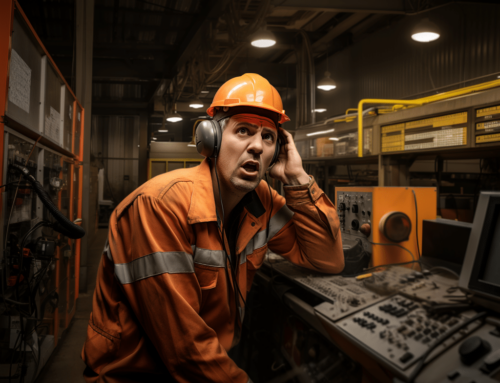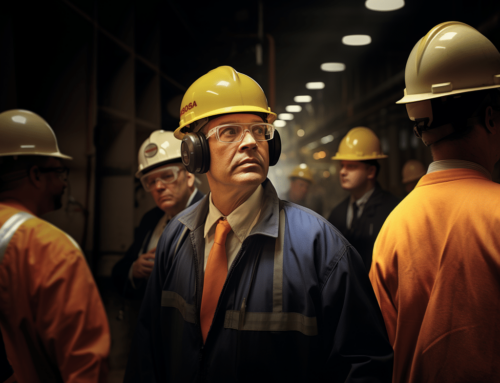Comprehending the Vital Role of Personal Protective Equipment in Occupational Health
The significant impact of the coronavirus pandemic underscores the indispensable role of Personal Protective Equipment (PPE) in sustaining a health workforce in healthcare settings.
From emergency services and health examinations to dealing with the challenges of the food supply chain, PPE, including different pieces like aprons, earplugs, face shields and respiratory equipment, serves as the first line of defense for frontline workers.
Understanding this equipment’s necessity in reducing infection control, minimizing hazards in the everyday workplace, and boosting public health is central to this discussion.
Let’s explore the relevance of PPE in various sectors, from your local grocery store’s housekeepers to healthcare workers at your neighborhood clinic.
Keep reading to witness the vital role of PPE in maintaining healthy and safe work conditions.
Understanding the Definition and Importance of Personal Protective Equipment (PPE)
Personal Protective Equipment, widely known as PPE, plays an integral role in ensuring safety in various health care settings and workplaces. With the rise of health threats such as the coronavirus pandemic, the utilization of PPE has skyrocketed in importance among health workers, including healthcare workers and housekeepers particularly in healthcare settings. PPE ranges from respiratory protection like respirators to body protection in the form of aprons, each serving unique functions in infection control.
Hand protection, therefore, becomes cardinal, especially amongst frontline workers. Whenever people working in health care, grocery stores, or other service sectors come in contact with potentially harmful substances. Similarly, hearing protection such as earplugs is crucial for those exposed to high noise levels, and eye protection like safety glasses or face shields protect against splashes or airborne particles. The assortment of PPE is vast, catering to different needs depending on the work conditions.
The National Institute for Occupational Safety and Health together with the Centers for Disease Control and Prevention frequently run risk assessments and hazard assessments. These assessments aim to reduce workplace injuries caused by inadequate PPE and poor safety measures. Their strategies often include conducting health examinations to perform apt risk assessments, thereby establishing pertinent guidelines for personal protective equipment use.
Indeed, prioritization of PPE applies to daily lives as well, all beyond the sole need of the health workforce. For housekeepers, PPE reduces the risk of back pain and other physical stress. For those in the food supply chain, from food supply to the grocery store, PPE ensures safety in handling food items. Scalia, on the other hand, emphasizes the importance of PPE in sectors like emergency services, showing how personal protective equipment can protect against health menaces such as the Chronic Obstructive Pulmonary Disease.
Identification of Different Types of PPE and Their Usage
It’s crucial to identify different types of PPE and comprehend their varying uses. For instance, PPE for body protection, such as aprons and suits, are widely used in healthcare settings for infection control, much more so in the wake of the coronavirus pandemic. These forms of protection are used by health workers, not just healthcare workers, to ensure their safety while they provide their services.
Amid the different types, respiratory protection is pivotal for health care workers, particularly those dealing with airborne diseases. This category includes various types of respirators that filter out harmful airborne particles, thus reducing the risk of respiratory infections. In the context of the coronavirus pandemic, the respirator has become a vital segment of PPE, crucial for those in healthcare settings and frontline workers.
Hand protection and eye protection are, however, universally necessitated, transcending the battleground of healthcare. They find their important place in numerous industries, from handling food supply at a grocery store to the manufacturing worksite. Gloves, safety glasses, and face shields protect the workers from direct contact or splashes of hazardous materials, securing them against possible injuries or infections.
Finally, the role of hearing protection should not be discounted, especially for workers operating in high decibel environments. Earplugs and earmuffs serve an important purpose of shielding the workers from potential harms like tinnitus or even hearing loss. From emergency services to industries with constant noise, these forms of PPE significantly contribute to preserving the health of the workers.
The Role of PPE in Combating COVID-19 in the Workplace
The coronavirus pandemic has indisputably escalated the importance of PPE in the workplace, in particular in healthcare settings. The virus’s transmission is primarily through respiratory droplets, and hence respiratory protection like respirators masks became crucial. Health care workers and frontline workers, facing the brunt of the pandemic, relied heavily on this form of PPE for their safety.
In addition, PPE like gloves and aprons acted as the first line of defense for health workers from coronavirus infections in the workplace. These pieces of equipment serve to protect against direct contact with the virus. Specifically, hand protection shields health workers from infectious agents, keenly needed considering the nature of their work.
Elevating further the need for personal protective equipment, COVID-19 ushered a demand for face shields and safety glasses. Used primarily for eye protection, these PPE guard against possible contaminations from aerosol sprays or splashes, a likely risk in healthcare settings. Consequently, they have become vital armor for health care workers during the pandemic outbreak.
Finally, COVID-19 demanded a rapid behavior change in many workplaces, including those outside of healthcare, to ensue the new required safety practices. Emergency services, grocery stores, and the food supply chain also adopted PPE usage to safeguard their employees. This highlighted that irrespective of the health crisis at hand, PPE is a consistent factor in maintaining workplace safety and setting a standard for future preparedness measures.
Ensuring the Proper Usage of PPE: Guidelines and Training
Proper usage of personal protective equipment is as essential as having the correct PPE. Following guidelines set by reputable organizations like the Centers for Disease Control and Prevention and the National Institute for Occupational Safety and Health is advised. These entities conduct regular hazard assessments and risk assessments to inform their guidelines, offering comprehensive instruction on correct PPE usage.
Healthcare settings, for instance, generally require rigorous attention to the donning and doffing of PPE due to the risk of infection. A health worker needs to carefully abide by these procedures to ensure they do not inadvertently become a carrier of the diseases they are seeking to treat or prevent. Training in these techniques is pivotal to ensure patient safety as well as their own.
In different work settings, the correct selection and application of PPE can vary. For instance, employees at a grocery store in the food supply chain may require different types of hand and body protection compared to those who work in healthcare. The training in correct PPE usage will similarly evoke differences, making customized training and risk assessments central to maintaining workplace safety.
Irrespective of work conditions, it’s paramount to ensure PPE is maintained, replaced, and disposed of correctly. This aligns with achieving the ultimate objective of protecting the health and well-being of workers and maintaining occupational safety. In this respect, PPE signifies much more than protective gear, it’s a commitment to keeping workplaces safe and healthy.
Regular Inspections for Maintaining PPE Safety
Regular inspections are critical in maintaining the safety and efficacy of personal protective equipment. Whether it’s body protection like aprons, respiratory protection through respirators, or hand protection with gloves, each item needs to be inspected regularly for damage or wear. These procedures will ensure the continued effectiveness of PPE in settings like healthcare or grocery stores in the food supply chain.
The Centers for Disease Control and Prevention along with National Institute for Occupational Safety and Health set forth stringent guidelines for PPE inspections. These involve not solely examining the physical condition of the gear but also assessing whether the equipment still provides the anticipated level of protection. For workers exposed to noise, for example, ensuring proper hearing protection via earplugs is crucial, and frequent checks can ascertain that these are still effective.
Amid such considerations, proactive inspections become integral in detecting potential issues. This approach helps organizations to anticipate problems and take appropriate steps before it escalates into hazards, thereby enhancing the overall health of workers. Furthermore, regular training on PPE inspections can instill a safety-first culture, ensuring its preservation as a workplace norm.
Finally, the commitment of organizations, from healthcare to emergency services, towards regular inspections enriches the trust among the workforce. This process eases worker anxiety, particularly among health care workers and frontline workers facing health threats including back pain or the coronavirus pandemic. With an active inspection regime, organizations are not just providing PPE but also diligence in establishing a safe work environment.
Exploring Markets for Procuring Quality Personal Protective Equipment
The procurement of quality Personal Protective Equipment (PPE) is a critical step in ensuring workers are adequately protected. From health care settings to the food supply chain, access to reliable marketplaces for purchasing quality PPE is essential. Procurement from reputable sources means workers are safeguarded with equipment that meets the necessary standards and guidelines.
The procurement process requires knowledge about each type of PPE and its specific uses, as well as its certification. For example, respiratory protection like respirators requires different considerations compared to earplugs used for hearing protection. Detailed understanding of the equipment and, in correlation, the suitable market is essential for acquiring effective PPE.
Online platforms have made procurement streamlined and more accessible, but it’s necessary to remember that quality should not be compromised for convenience. Therefore, before making a purchase, buyers must validate the credibility of the marketplace, scrutinize customer reviews, and confirm that the PPE is compliant with the standards set by organizations like the Centers for Disease Control and Prevention.
Furthermore, in the procurement process, it’s crucial to consider after-sales services such as returns, exchanges, and customer support. This is as important as the product itself because they ensure a smooth process, particularly when bulk purchasing PPE. Evidently, acquiring quality PPE is not just about the purchase but also about selecting a trusted partner who stands by their products.
Conclusion
Clearly comprehending the vital role of personal protective equipment (PPE) in occupational health is fundamentally important.
Whether it’s healthcare settings or the food supply chain, quality PPE provides a critical line of defense, protecting workers from potential health hazards.
Equally important is understanding the correct usage and regular maintenance of these protective gears.
Furthermore, the procurement of PPE from trusted sources further supplements the objective of safeguarding the workforce.
In essence, PPE becomes a focal point in cultivating a culture of safety at the workplace, showcasing its indispensible importance in upholding occupational health standards.







